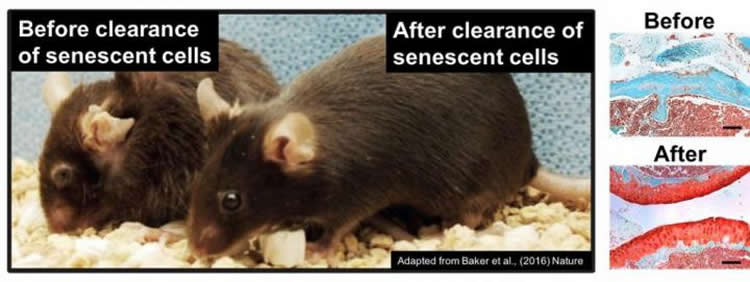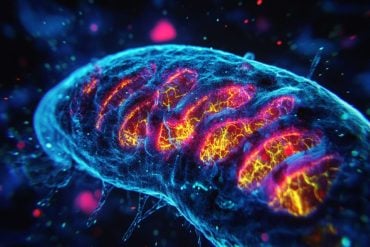Summary: Researchers report a targeted removal of senescent cells could delay the onset of age related pathologies.
Source: UNIST.
A recent study, led by an international team of researchers confirms that targeted removal of senescent cells (SnCs), accumulated in many vertebrate tissues as we age, contribute significantly in delaying the onset of age-related pathologies.
This breakthrough research has been led by Dr. Chaekyu Kim of the Johns Hopkins University School of Medicine, who is now at UNIST, and Dr. Ok Hee Jeon of the Johns Hopkins University School of Medicine in collaborations with the Mayo Clinic College of Medicine, the Buck Institute for Research on Aging, the University Medical Center Groningen, Unity Biotechnology, Inc., and the University of California, Berkeley.
In the study, the research team presented a novel pharmacologic candidate that alleviates age-related degenerative joint conditions, such as osteoarthritis (OA) by selectively destroying SnCs. Their findings, published April 24th in Nature Medicine, suggest that the selective removal of old cells from joints could reduce the development of post-traumatic OA and allow new cartilage to grow and repair joints.
Senescent cells (SnCs) accumulate with age in many vertebrate tissues and are present at sites of age-related pathlogy. Although these cells play an essential role in wound healing and injury repair, they may also promote cancer incidence in tissues. For instance, in articular joints, such as the knee and cartilage tissue, SnCs often are not cleared from the area after injury, thereby contributing to OA development.
To test the idea that SnCs might play a causative role in OA, the research team took both younger and older mice and cut their anterior cruciate ligaments (ACL) to minic injury. They, then, administered injections of an experimental drug, named UBX0101 to selectively remove SnCs after anterior cruciate ligament transection (ACLT) surgery.
Preclinical studies in mice and human cells suggested that the removal of SnCs significantly reduced the development of post-traumatic OA and related pain and created a prochondrogenic environment for new cartilage to grow and repair joints. Indeed, the research team reported that aged mice did not exhibit signs of cartilage regeneration after treatment with UBX0101 injections.

According to the research team, the relevance of their findings to human disease was validated using chondrocytes isolated from arthritic patients. The research team notes that their findings provide new insights into therapies targeting SnCs for the treatment of trauma and age-related degenerative joint disease.
Prior to this study, Johns Hopkins Technology Ventures (JHTV) granted UNITY Biotechnology Inc. the right to use the intellectual property around the senescent cell technology. UNITY is a company aiming to develop therapeutics that address age-related diseases. Last October, the company announced $116 million in Series B funding from some of the big names in venture capital, including Amazon CEO Jeff Bezo’s venture fund Bezos Expeditions, Mayo Clinic Ventures, Venrock, and ARCH Venture Partners. UNITY has completed a rigorous screening and preclinical testing process of candidate drugs, discovered in this study, and is launching a new clinical trial to assess its first drug, for patients with osteoarthritis of the knee this year.
This study has been also conducted collaboratively by twelve other researchers, including Dr. Jennifer Elisseeff, Director of the Translational Tissue Engineering Center and Morton Goldberg Professor of Ophthalmology at the Johns Hopkins Wilmer Eye Institute, Professor Jan M. Van Deursen’s team of the Mayo Clinic College of Medicine, and Professor Judith Campisi’s team of the Buck Institute for Research on Aging.
Source: JooHyeon Heo – UNIST
Image Source: NeuroscienceNews.com image is credited to Baker et al., (2016) Nature.
Original Research: Abstract for “Local clearance of senescent cells attenuates the development of post-traumatic osteoarthritis and creates a pro-regenerative environment” by Ok Hee Jeon, Chaekyu Kim, Remi-Martin Laberge, Marco Demaria, Sona Rathod, Alain P Vasserot, Jae Wook Chung, Do Hun Kim, Yan Poon, Nathaniel David, Darren J Baker, Jan M van Deursen, Judith Campisi & Jennifer H Elisseeff in Nature Medicine. Published online April 24 2017 doi:10.1038/nm.4324
[cbtabs][cbtab title=”MLA”]UNIST “Removal of Aging Cells Could Extend Human Life.” NeuroscienceNews. NeuroscienceNews, 9 June 2017.
<https://neurosciencenews.com/aging-cells-longevity-6880/>.[/cbtab][cbtab title=”APA”]UNIST (2017, June 9). Removal of Aging Cells Could Extend Human Life. NeuroscienceNew. Retrieved June 9, 2017 from https://neurosciencenews.com/aging-cells-longevity-6880/[/cbtab][cbtab title=”Chicago”]UNIST “Removal of Aging Cells Could Extend Human Life.” https://neurosciencenews.com/aging-cells-longevity-6880/ (accessed June 9, 2017).[/cbtab][/cbtabs]
Abstract
Local clearance of senescent cells attenuates the development of post-traumatic osteoarthritis and creates a pro-regenerative environment
Senescent cells (SnCs) accumulate in many vertebrate tissues with age and contribute to age-related pathologies presumably through their secretion of factors contributing to the senescence-associated secretory phenotype (SASP). Removal of SnCs delays several pathologies and increases healthy lifespan8. Aging and trauma are risk factors for the development of osteoarthritis (OA)10, a chronic disease characterized by degeneration of articular cartilage leading to pain and physical disability. Senescent chondrocytes are found in cartilage tissue isolated from patients undergoing joint replacement surgery yet their role in disease pathogenesis is unknown. To test the idea that SnCs might play a causative role in OA, we used the p16-3MR transgenic mouse, which harbors a p16INK4a (Cdkn2a) promoter driving the expression of a fusion protein containing synthetic Renilla luciferase and monomeric red fluorescent protein domains, as well as a truncated form of herpes simplex virus 1 thymidine kinase (HSV-TK). This mouse strain allowed us to selectively follow and remove SnCs after anterior cruciate ligament transection (ACLT). We found that SnCs accumulated in the articular cartilage and synovium after ACLT, and selective elimination of these cells attenuated the development of post-traumatic OA, reduced pain and increased cartilage development. Intra-articular injection of a senolytic molecule that selectively killed SnCs validated these results in transgenic, non-transgenic and aged mice. Selective removal of the SnCs from in vitro cultures of chondrocytes isolated from patients with OA undergoing total knee replacement decreased expression of senescent and inflammatory markers while also increasing expression of cartilage tissue extracellular matrix proteins. Collectively, these findings support the use of SnCs as a therapeutic target for treating degenerative joint disease.
“Local clearance of senescent cells attenuates the development of post-traumatic osteoarthritis and creates a pro-regenerative environment” by Ok Hee Jeon, Chaekyu Kim, Remi-Martin Laberge, Marco Demaria, Sona Rathod, Alain P Vasserot, Jae Wook Chung, Do Hun Kim, Yan Poon, Nathaniel David, Darren J Baker, Jan M van Deursen, Judith Campisi & Jennifer H Elisseeff in Nature Medicine. Published online April 24 2017 doi:10.1038/nm.4324






